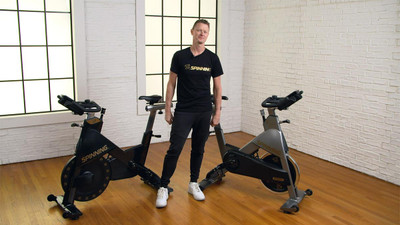
Josh Taylor’s Expert Advice on Friction and Magnetic Resistance Spinning® Bikes
Posted by Spinning® on Mar 18th 2024
“Give me a turn to the right!” That familiar cue heard in Spinning® classes everywhere – the one that everyone understands to mean add resistance…make it harder…get after it. But what actually happens when we turn the resistance knob to the right? Depending on the type of bike, either a brake pad presses down on the flywheel, or magnets move closer to it. These are the two types of resistance systems, each with its own set of advantages.
Some people prefer one system over the other, and mag bikes are often the favorite. But few people really know the latest Spinner® bike engineering nuances that make BOTH types winners. If you’re researching bikes to buy, or you’re an instructor who likes to be informed about the most important piece of equipment in your class, let us share some intel on friction and magnetic resistance systems.
Watch this video to hear Josh Taylor break down the differences between the two types of bikes.
In this video he does a deeper dive into the magnetic resistance system of the newest Spinner® Chrono® bike.
|
Both types of resistance mechanisms make it harder to turn the flywheel when pedaling, thereby creating “the load” that you work against.
Friction-based resistance involves a leather brake pad that comes down on top of the flywheel to create physical pressure. Magnetic-based resistance uses magnets to create an eddy-current resistance at the flywheel. |
LOW-TO-NO MAINTENANCE:
There’s a myth that we need to debunk. Many people believe that mag bikes are the only way to go because they require less maintenance. It’s true that with magnetic resistance, the magnets never actually contact the flywheel, so yes, there's little to no maintenance with the resistance system, unless a magnet needs to be replaced, which is rare.
But what about maintenance on a friction bike with a leather brake pad? Truth be told, friction resistance maintenance is almost fool-proof – issues are most often extremely easy to fix. There’s some routine maintenance required to keep the leather pad lubricated once a year, and occasionally, the pads also need to be replaced if they’re worn down. But this is also easy to do, inexpensive, and seldom necessary.
Bottom Line: It's rare that there's any maintenance needed with a magnetic resistance system. With a friction bike, there is a little bit of annual maintenance, but it's easy and inexpensive.
WATCH: Magnetic vs Friction Resistance Bikes from Spinning®
HEAVY RESISTANCE FOR HILL CLIMBS
Now let’s talk about resistance. Let's first consider the magnetic bike, in which the flywheel must be moving substantially past the bike's magnets to create an eddy current that provides the resistance. In this case, the load depends on the speed of the flywheel and the magnets' position. And to produce that magnetic load or eddy current, the flywheel speed must be significant.
The problem with most other mag bikes is that at a slower cadence (60 RPM or slower, which would be akin to feeling like you're pedaling into a big headwind or on difficult terrain), the bike simply won’t generate enough eddy current to give you a substantial amount of resistance at a low RPM. Meaning: You can’t simulate a big hill where you’re climbing with all your power at a slower cadence.
However, our Chrono® accommodates for this with a heavily weighted perimeter flywheel and strong magnets so you CAN ratchet up that resistance (even at 50 RPM) and climb hard compared to other mag bikes on the market.
|
Our Chrono® also provides a good amount of inertia, which gives both the rhythm-based rider and performance-based rider an amazing feel in both the drivetrain and resistance, no matter what terrain or movement you're riding in class. |
On a friction bike, it’s the physical contact of the brake pad on the flywheel that delivers the resistance, regardless of how fast or slow you’re pedaling. So, if you’re doing any kind of performance training (akin to the road), you’re going to appreciate the ability to simulate that heavy, steep hill as you increase resistance. This is particularly important for the instructor or rider who wants rides with steep terrain. Friction is also great for a HIIT class when you want load out of the gate.
Bottom Line: While some magnetic resistance bikes cannot deliver heavy resistance on steep hills, the Chrono® is engineered to do just that. So it’s comparable to friction bikes in that regard.
WATCH: Magnetic Drivetrain on the Chrono® from Spinning®
|
Explore the newest line of Spinning® Commercial Bikes.
Read more about the Chrono®. |
